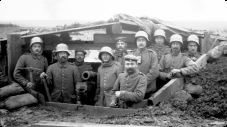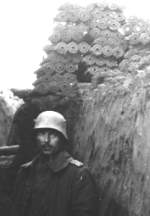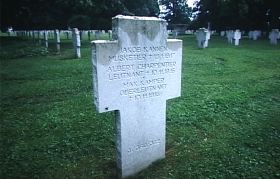genealogy
Index
Part 1
Part 2
Part 3
Part 4
Part 5
Part 6
Part 7
German
Audiofile
on this part
(German)
Death at the Somme
At the Kaemper family three tin boxes emerge. They contain negatives. Format six to nine, obviously shot in the First World War. We can hardly expect to get the prints from the laboratory.
We are quite familiar with Max after all our research. But now almost one year of his life is spread in front of us, seen by his own eyes. We cannot find any written testimonials from him from this period. But what he saw, what he considered worth preserving on pictures tells perhaps more than a box full of letters.
The departure from Berlin: Photos show family members, carefully posing for the camera. The ladies seem to be somewhat anxious, the gentlemen look serious and resolute.
A speaker´s platform, oak leaf decoration, many somberly dressed and top-hatted gentlemen, many in uniform. In the background the Brandenburg Cathedral. No. 239 Artillery Reserve Regiment goes to war. Cannons are loaded on waggons. In front of the train the unit poses for a memory picture.
The journey goes to the East. Max is interested in technical details, in signal towers and railroad junctions, cannon loading and locomotive types.
In Poland, Max and his comrades are quartered in a small village. An accumulation of straw covered wood huts. It is bitterly cold but obviously this does not affect the good mood. In the living room of the farmers the officers have their coffee. Outside in the snow the lower ranks provide firewood and make the laundry. No feeling of war, strain or fear in the pictures.
Spring comes and Max goes West. A stately French farm in the Vosges Mountains is chosen for quarters and again there is little evidence that we are in the middle of a world war. Max photographs fields and meadows, calves and pigs. He takes a picture of himself on his horse. We see merry German soldiers cutting asparagus and feeding rabbits, drinking coffee under fruit trees. The first medals are celebrated with champagne: the war - a grand pleasure.
 Max
makes the old farmer's wife pose beside the cast-iron stove and directs
his lens toward the young girls making hay. One of the beautiful ones sends
a coquettish glance from under her large straw hat to Max - only the ever
present guard in the background reminds of the fact that there is war.
Max
makes the old farmer's wife pose beside the cast-iron stove and directs
his lens toward the young girls making hay. One of the beautiful ones sends
a coquettish glance from under her large straw hat to Max - only the ever
present guard in the background reminds of the fact that there is war.
A new scene. Max has shifted to Northern France. At the river Somme there has been raving for some weeks a bloody trench warfare with hundreds of thousands of victims on both sides. The German High Command had given order to resist the attacking Frenchmen and Englishmen at any cost. More and more fresh units are sent to the front.
 Engineers
like Max are important in this war. Their cannons, their tanks, their logistic
skill shall bring about the decision. All their art of engineering is now
used in order to kill on an industrial scale.
Engineers
like Max are important in this war. Their cannons, their tanks, their logistic
skill shall bring about the decision. All their art of engineering is now
used in order to kill on an industrial scale.
Max experiences the true face of the war. He takes pictures of bomb craters and grave fields, destroyed farmhouses and shot-up church towers, wounded comrades.
Whether Max wrote down his experiences in letters is unknown. But on the right and left of him there were some, who found words for the horrific scene:
"Hill No. 60 is blown into the air by the Englishmen, together with three men of the observation unit. Many more died, suffocated. Everywhere and never ending the fire of shells exploding and guns firing. The Man of the Century, the Engineer, has caused another Great Flood with leaden hail-storms, with flaming, smoking and cracking fountains, with deadly lightnings and continuous thundering. With men who came here herded together on ships and trains, who were thrown into this inferno only to perish in it before they could even take a breath. The earth brings up ten thousands of new muzzles every hour whose sharp teeth flash and tear up men. Its torn, ugly coat soaks up innumerable precious scarlet drops. "
Fighting around the artillery position
commanded by Max becomes more violent now. Max photographs mainly his comrades.
From picture to picture the faces turn more serious, sadder, apathetic.  One of the last pictures shows Max in the trench, taken by autorelease.
Between high earth walls Max in his wide army coat can hardly be recognized
under the steel helmet. High above him a mountain of ammunition. He still
had time to process the picture in a shelter and to stow it carefully in
a tin box. Later, after the war, he would surely find time to make prints
of his war memories he may have thought. But it never came to that. A direct
hit ended his life on November 10, 1916.
One of the last pictures shows Max in the trench, taken by autorelease.
Between high earth walls Max in his wide army coat can hardly be recognized
under the steel helmet. High above him a mountain of ammunition. He still
had time to process the picture in a shelter and to stow it carefully in
a tin box. Later, after the war, he would surely find time to make prints
of his war memories he may have thought. But it never came to that. A direct
hit ended his life on November 10, 1916.
The faint photo of a grave, in the same envelope the remainders of a dried flower. For Elsbeth Kaemper a world broke down with the death of her husband. How often will she have looked at this picture and read the letters in which the incomprehensible was described?
Mrs. Kaemper:
"These are the letters of condolence his father received. /.. / In this one it says: "... mournful and sad at the death of our dear Battery Commander, my good and able friend, Lt. Kaemper, the son of Your Excellency. He died at noon on November 10th together with two other battery commanders when their shelter was blown up by a direct hit .." -- " his corpse was found last night. Helmut, who was on battery duty that week while the others were in resting position, immediately sent people to dig him out. But he could not be rescued. He was dead at once. And the debris of the shelter were full of toxic gas.
Helmut adds, that the death of Lt. Kaemper is a severe loss to the Battery. He was like a father to his people and enormously popular."
We set out to find the grave. The lady at the Tourist Information in Arras thinks she has misunderstood when we ask for German war graves. " Vous êtes allemands? - You are Germans? " That had never happened before. Englishmen, Canadians, even Australians came in order to visit the old cemeteries. But Germans? Perhaps they are embarrassed, she reckons.
We meet a young French historian who explores the details of the " Great War"; with a somewhat strange enthousiasm. He shows us the way to the largest German graveyard. Precisely arranged, endless lines of white crosses on a well maintained green. On each cross three names, three death dates. They died young, many just 18, 19 years old. A monument reminds the living and affirms that these boys did not die in vain. If they had been given similar respect during their lifetime ...
The gardener produces a bulgy catalogue with long lists of the dead buried here and the exact location of their final resting places. Soon we stand at Max Kaemper's grave. A white marble cross, overshadowed by high trees on the War Cemetery of Cambrai. Our search for Max has come to its last stage.

In the Mammoth Cave National Park, Chuck hung up the picture of Max in the Rangers Lounge. Especially the female cave guides like to have a look at it. Such a handsome man!
Rick, the biologist, fixed the picture of Gerta over his desk. Little wonder that Max was so fond of her, he comments.
The Kaemper family plans a journey to America for next summer. Klaus, the grandson of Max, wants to take his cello. He has played in many places. But a concert in Mammoth Cave as a hommage to his grandfather - this would be something very special.
Postscript
In October 2000 three of Max´s grandchildren and his daughter-in-law visited Mammoth Cave. They spent some wonderful days with Chuck, Rick and Stan who showed them the places first seen and mapped by Max Kämper 92 years ago.


| Previous | Start |